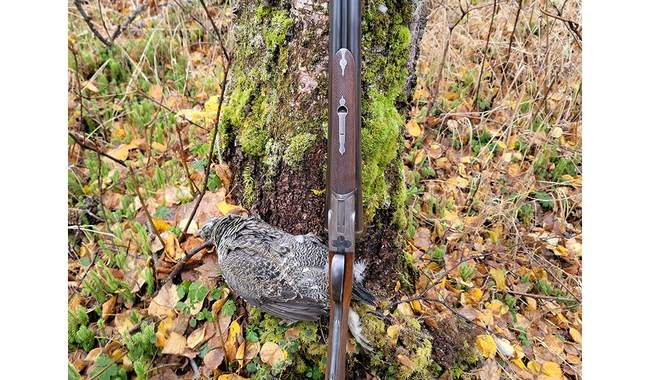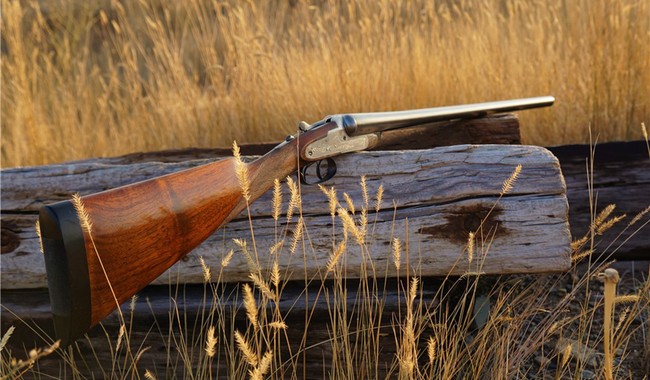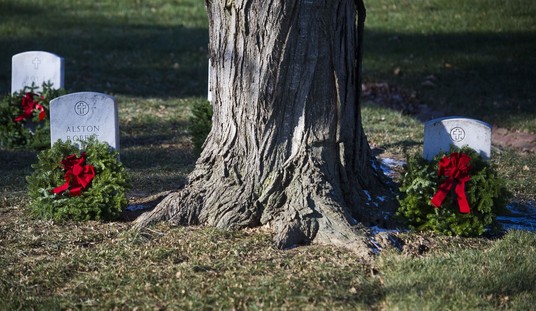Last fall, loyal sidekick Rat came hither to the Great Land for his first foray here. We have been hunting deer, elk, and small game in the Colorado Rockies since 2007, but this was his first visit here. We had intended to hunt grouse and ptarmigan, but the vastness of Alaska made its impression on my young partner (at least, he’s young compared to me) and we spent more time sightseeing than hunting birds. It was a great week nonetheless, as there is an awful lot to see in the Great Land, and we only covered a small part of it.
He did take notice of my favorite bird gun, though, as he had not seen it before. I have a lovely upland bird gun; a hand-made British side-by-side double, made by a Birmingham gunsmith, Henry Tolley, in 1892. It’s a joy to handle, weighing in at a hair over six and a half pounds, and balances just a skosh ahead of the hinge. The 28” barrels have chokes roughly at Skeet and Modified, according to my choke gauge. It sports lovely laminate barrels sleeved and proofed for nitro shells, the only catch being its short 2 ½” chambers, which requires I buy rather expensive ammo imported from the UK. But it's a great piece, light, fast, quick on the birds, and an ounce of British #7 shot will put even big spruce grouse down with authority.

That, and my Citori, are my favorite bird guns. Despite my modest collection of old Model 12 Winchesters and Browning Auto-5s, when it comes time to go out in the bush looking for grouse or ptarmigan, I’m usually more inclined to pick up one of these two doubles.
Why limit myself to two shots before reloading? Why would I prefer a double over one of John Browning’s finest designs, or the pump gun known rightly as the Perfect Repeater? Mind you, I use those as well, especially a neat, light 16-gauge Model 12 that's also fast and handy. But when heading out for birds, more often than not, I take a double. Why?
Well, here’s why and I’m going to tell you.

Doubles – like my Tolley double – are just plain great in the field. During a day of bird hunting, you spend a lot more time carrying a shotgun than shooting it, so weight matters; a heavy gun, like my Model 12 Black Diamond, is great on the trap range when you might be firing 100-150 rounds in a day’s time. But in the field, a lighter gun may give you a little more… feedback, whereas hunting upland birds, it’s not common to only fire 10-12 rounds, but you’re toting that thing around the whole time. As we get older, that matters.
See Related: The Dick Cheney School of Marksmanship
Doubles are reliable. They don’t jam. They are simple and easy to operate, and if a firing pin or mainspring breaks, you still have one operational barrel. Pumps and autos have tons of moving parts, and a breakage not only takes the gun out of commission but requires a complete disassembly by an accomplished gunsmith to repair; I’ve repaired break-open singles myself, replacing both firing pins and mainsprings, and a double is pretty much a single-shot times two. Granted, I’ve performed like repairs on pump guns as well, but I have an extensive gunsmith’s tool kit, and while not a pro, I’m probably a better-than-average tinkerer.
There’s another reliability issue that applies to older guns. Some older pumps and autos, mostly the ones made before WW2, were made to shoot roll-crimp shells with over-shot wads. The modern star-crimp shells, when fired, open up to a greater length. I’ve seen a few old Model 12s, most notably 16-gauge versions, that won’t eject star-crimp empties. It’s an odd problem you don’t hear much about. But a cautionary note is in order, with older doubles; a star crimp in those guns, especially with short chambers, are likewise designed for roll-crimp shells. Oh, they will load and eject just fine, but while I’ve never heard of it happening, I’ve always been concerned that the star crimp would unfold too far into the forcing cone, resulting in higher pressure in an old gun. The British loads I use in my Tolley double are roll-crimp, and that’s the only sort I’ll use.
Doubles are compact. A double, while being light and handy, also gives you more barrel in the same overall length. A double has a minimal receiver; there is no long repeater action to add several inches to the overall length. A pump gun with a 26” barrel may be the same length as a double with 28” barrels. That made more difference back in the black-powder days than it does now, with faster-burning smokeless powders, heavier loads generally use slower-burning powders – like the big 3 ½” Roman candles I can use in my Citori for waterfowling. The Browning’s 28” barrels handle those big loads just fine. Also, while some pumps, like my Model 12s, break down to fit in a small carrying case, most don't — but all doubles do, making them easier to stash in the truck.
Doubles are easy to clean. As long as I didn’t get rained or snowed on – neither of those are a rare event during bird season in the Great Land – usually a good wipe down with a silicon cloth and a couple of passes through the barrels with a bore snake does the trick, and the gun can go back into the safe. A pump or auto is a little more involved.
And, finally, doubles are beautiful. My Tolley has not only the lovely laminate barrel, but the receiver as well as the metal furniture on the stock and fore-end are carefully hand-engraved, and even the screw heads are not only engraved, but the slots are perfectly aligned fore-and-aft. That gun is not only light and handy, but it’s pretty as well. Hammer guns are even more notable. Some years back, I stumbled across an old 12-gauge hammer double at a gun show and picked it up for a song, as it had a broken mainspring on one of the nicely engraved sidelocks. At first, I harbored notions of getting it back into shooting trim, as it was in great shape otherwise, with about 80 percent of its original finish and mirror-bright bores on Improved Cylinder/Modified barrels.
We were living in the Denver area at the time, so I took it around to several local gunsmiths to see if a new mainspring could be fabricated; the one guy I found who had the skills to do it first asked what I’d paid for the gun.
“$125,” I told him.
“It would cost twice that to fix it,” he said. “At least. My advice is to take it home and hang it on the wall.” So I did, and it remains a wall-hanger to this day, decorating the wall in our Susitna Valley home’s living room.
Don’t get me wrong. I do love my pumps and my autos. The Model 12 is still the Perfect Repeater and the gold standard against which all pump shotguns are measured; every young engineer designing a slide-action scattergun must, at some point or another in the process, has to ask himself, “How will this stack up against the Model 12?” And I am fond of my Browning Auto-5s as well. A lot of newer guns, the action feels a little gritty and rough, or at least it seems that way to me. But pick up a Belgian Auto-5, pull back the bolt, and let it slam forward – smooth as oiled glass.
See Related: Sunday Gun Day Vol. II Ep. XIV - The Magnificent George Madis
A double, though, has its own appeal – and that is certainly why, centuries after the current form of both side-by-side and over/under doubles has been set, long after cartridge breechloaders gave one a big rate-of-fire advantage over front-stuffers in which a second barrel was the only way to get a second shot in a hurry – after all that, doubles are still popular with America shooters. On the trap or skeet range, on the sporting clays course, or on the game fields, you still see a lot of doubles. I suspect that it will hold true a hundred years from now.
And, if you catch me wandering the Alaskan woods looking for spruce grouse or ruffies, I’m liable to be toting that Tolley double or my Citori, for all of these reasons, but mostly just because I like them.
That’s reason enough, after all.















